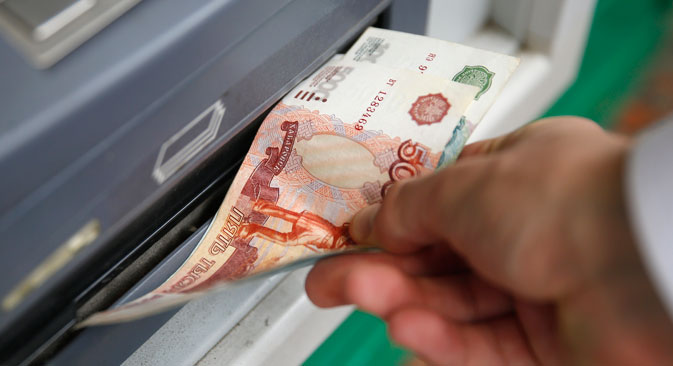
Bank puts GDP growth at about 0.5 percent, regardless of political situation. Source: Reuters
According to a World Bank study, by the end of the year the Russian economy will have grown by 0.5 percent – despite the standoff with West over Ukraine and the imposition of sanctions by the EU and U.S. This means that Russia will be able to avoid slipping into recession this year. However, future development depends on the decrease or escalation of tensions between Russia and the West.
As a result, the World Bank has prepared three possible scenarios for the development of the Russian economy. The baseline scenario presumes that GDP will continue to grow next year – if nothing changes – but growth will be minimal, 0.3 percent and 0.4 percent in 2015 and 2016. Next, according to the optimistic scenario, if geopolitical tensions disappear and the sanctions are lifted by the end of 2014, then Russia’s economy may accelerate to 0.9 percent in 2015 and 1.3 percent in 2016. The pessimistic scenario assumes stricter sanctions and, tied to this, a fall in GDP by 0.9 percent in 2015 and 0.4 percent in 2016.
Within the margin of error
According to experts, GDP growth of 0.5 percent is a very likely scenario. “Half of a percent is a value that can be considered a statistical error in prognostication,” says Konstantin Korishenko, head of the department of capital markets and financial engineering at RANEPA (The Russian Presidential Academy of National Economy and Public Administration).
“Overall, there has been a slowdown in the rate of growth happening over the last few years: the current foreign political situation has just exacerbated this trend. One of the key factors influencing this economic slowdown is the decrease in the rate of growth of monetary supply. It is hard to ensure a high rate of growth when monetary inflation is not increasing at the necessary speed,” he explains.
According to Korishenko, this is tied in large part to balance of payment indicators. Through 2008, the main source of money in the economy was the high prevailing account balance, as well as the capital flow. Now things are reversed. A significant outflow of capital is being observed and Korishenko is convinced that the trade balance does not improve the current picture.
Moreover, in the opinion of Investcafe analyst Timur Nigmatullina, in principle it is difficult to predict the dynamics of Russian GDP with any accuracy over 1 or 2 percentage points because oil prices have a strong influence due to their effect on the trade balance and because of the difficulty of assessing the shadow economy and state spending.
“The World Bank prognosis is within the margin of error, but I would treat it with a dose of skepticism,” he says.
Two scenarios
In any case, according to the World Bank study, geopolitical stability is insufficient for the growth of the Russian economy.
“The Russian economy is, possibly, close to achieving the maximum level of its potential output,” the report states. IMF experts warned back in 2013 that the Russian economy was approaching its potential level of output.
Alexei Baksakov, chief of the Valuation Department at FinExpertiza Audit and Consulting Group, argues that the real prospects of the Russian economy can be placed squarely into two categories. According to him, the first scenario presupposes an easing of the earlier imposed sanctions followed by market growth and the active launch of deferred investment programs in industry.
“In this case the growth of the Russian economy in 2014 could already be 0.7-0.8 percent or more; most likely it would attain indicators of 1-1.2 percent,” said Baksakov. As for the second scenario, it presumes an escalation in the confrontation between Russia and the West and a freezing of tensions. In that case, the figure for 2014 will most likely be 0.3-0.5 percent, and after that economic growth may well start bearing negative indicators.
However, according to Anton Soroko, an analyst at the Finam investment holding company, the most negative forecasts that were expressed at the very beginning of the Ukrainian crisis have not manifested themselves.
“GDP will grow all the same, even if at a symbolic 0.5 percent, and by the end of 2015 it is quite possible to attain the 0.8-1.0 percent levels predicted in the optimistic scenario,” he says.
Despite the sanctions, the Russian economy remains highly integrated into the global economy, according to Alexei Kozlov, chief analyst at UFS IC. Moreover, he said it is worth keeping in mind that the limitations imposed by Russia on the importation of foodstuffs from the EU and the U.S. and the related need for import substitution could raise the rate of activity by Russian food producers and producers in related industries.
According to data provided by Rosstat, industrial manufacturing grew by 1.5 percent in the first half of the year, with several industries showing dramatic growth. For example, the building of ships, aircraft, spacecraft, and other transport equipment has increased by 26.9 percent.
All rights reserved by Rossiyskaya Gazeta.
Subscribe
to our newsletter!
Get the week's best stories straight to your inbox